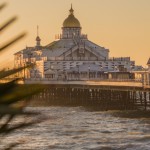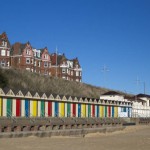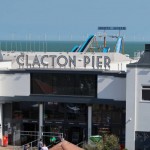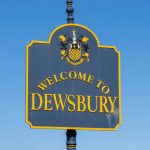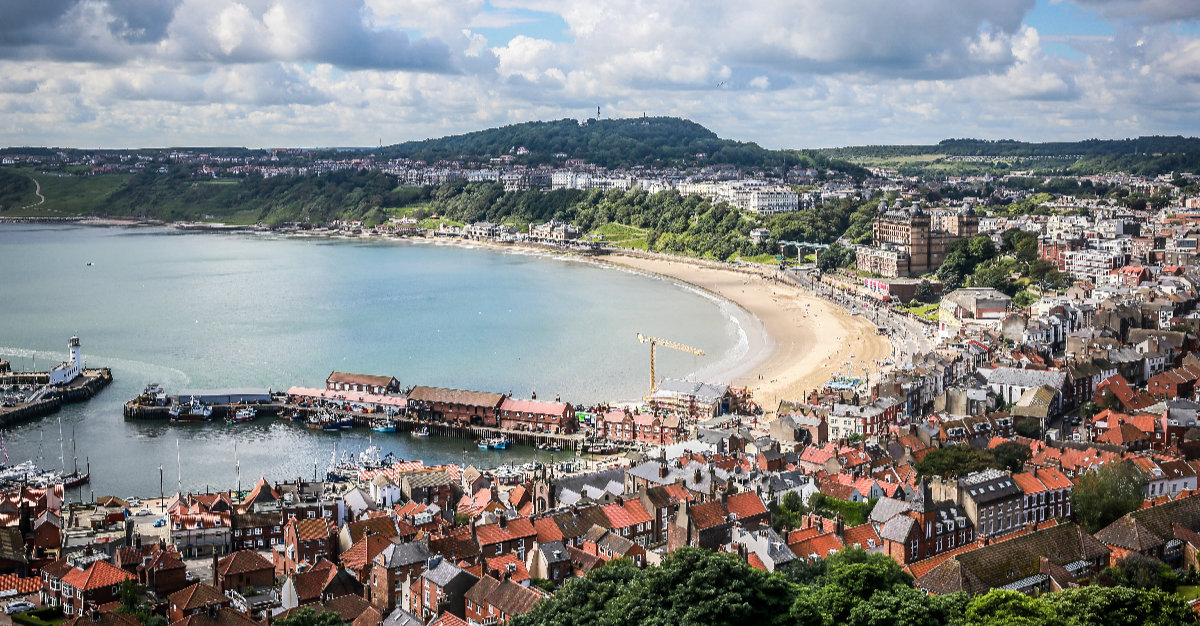
Scarborough – Much More Than Just A Seaside Holiday Destination!
Like a day at the seaside but also want a few things to do when the novelty of the beach wears off? Then Check out our guide to Scarborough the latest on our list of UK seaside towns to cherish… one-time big game fishing resort, home of the fair immortalised in song & a great place to have fish and chips by the sea.

As you can see it’s quite stunning on a nice day.
Image: MCWorldEnt/Shutterstock.com
Intrigued? Well, stay tuned, for the best bits of Scarborough… but let’s start with the early days.
The Earliest Days of Scarborough.
There is plenty of evidence to indicate that Scarborough has been inhabited for a long time, in some shape or form, possibly as early as the late Bronze Age thanks to archaeological excavations finding evidence of an ancient Hill Fort under the site of the old Castle. A bronze age sword found there could date from as early as 900BC. Its strategic location also led to the Romans building a signal station here which formed part of a chain along the Yorkshire coast. They left Britain in the early 5th Century and not a lot is known about the intervening years until the Vikings arrived.
A Town Is Formed
The actual forming of the area as a town is attributed to a Viking raider Thorgils Skarthi who founded it as Skarðaborg and he also possibly nearby Flamborough (Fleinaborg) around 966 AD and so began its early torrid history. In 1066 Scarborough was burned to the ground by Danish raiders under Harald Hardrada and Tostig Godwinson and with most of its inhabitants slain the town was in ruins and uninhabited at the time of the Domesday Book twenty years on. Flamborough survived though, but it was listed as having a single smallholder with a lordship value of 10 shillings! Still better times were ahead, at least until the Scots came!
Around 1130 the basic structure of the castle began to take shape and Scarborough began to have some importance as a harbour settlement and in 1155 it was allowed to hold a market by the end of Henry II’s reign in 1189 the Castle was an important strategic northern stronghold and the town was granted the title of Royal Borough in 1181 giving its citizens the liberties as those granted on the city of York!
Edward II Takes Over
After Henry II was gone and Edward II was on the throne, the castle had been dubbed ‘Scarborough’ Castle and the name of the town had evolved to the one we know today. Edward had many courtly favourites (most of them men) and he granted the castle to one of them… a man called Piers Gaveston, the first-ever Earl of Cornwall… he liked him a lot.
Because of this association to the crown, the castle was laid siege to when Edward fled. The Earl was captured from Scarborough castle and dragged to Warwick Castle, there to be executed. It was not a happy ending for a man so devoted to his king.
Following the Scottish rebellion stemming from the Battle of Bannockburn in 1314, most northerly of the English towns began to become the target of raids largely aimed at forcing the English nobles to the negotiating table. The first major target was Berwick Upon Tweed which returned to Scottish rule in 1318 and soon all the towns on the east coast fell under their crosshairs. This led to several raids on the town cumulating with its burning to the ground by Robert the Bruces forces led by Sir James Douglas (The Black Douglas) later that year.
Medieval and Later
Scarborough developed as a town in 1626 when a local woman named Thomasin Farrer found slightly acidic waters running from a cliff outside of town, the whole area became known as a spa destination. The baths were built around the waters, with a local scientist, Dr Robert Wittie, writing about the place in 1660. By that time, however, Mrs Farrer was long gone, and the town had changed hands more times than we can count.
The English Civil war in the 1640s was what ultimately stunted the growth of this now-famous spa town… not that anyone was thinking about holidaying while the nobles were all running around chopping each other’s heads off. Still, the town would have grown quicker without all the violence, sieges, and death. By the end of the civil war, the town was fairly well ruined, but the spa waters summoned people back, one at a time.
Scarborough spa was the first-ever seaside resort in Britain and it grew steadily on this reputation. If it hadn’t been for Mrs Farrer’s acidic waters, we might not have any Scarborough to talk about today. Her discovery meant that Londoners adored Scarborough and came here in droves… even pulling it out of ruins and elevating it back to its former glory. 1660 saw the scientist’s book published and a wealth of new visitors. Scarborough grew in success and size. Rolling Bath machines were later added in the 18th century, finishing the ideal of the spa town on the coast.
The Industrial Era of Scarborough
During the industrial era, the spa waters were being drunk by everyone. The turn of the century saw the Victorians popularize bathing in seawater, so the appeal of Scarborough was doubled in value. Ships were built here, and fisherman docked in the harbour and brought in daily catches. The town thrived as a genteel seaside resort, far from the bustle and bold noise of the Industrial Revolution. At the turn of the 18th and 19th century, Scarborough had a population of around 6k, with more flooding the area every summer. In 1806, Scarborough lighthouse would be built.
Here Comes The Train
In 1845 the Railway came to town, finally connecting the working and middle classes to the seaside. As a spa resort, seaside resort, a fishing town, shipbuilding yard, and port town – Scarborough boomed. It was here that thousands of holidaymakers from factories across Yorkshire would flock to in the fair fortnights of summer. Scarborough lost its high-class feel and gained a reputation as somewhere everyone could gain affordable luxury… even just for a few days a year.
Shipbuilding declined gradually, with the population at the end of the 19th century 30,000 people. The Improvement Commission was set up in 1805, allowing an elected group to light, pave and clean the streets. In 1829 the Rotunda Museum opened, closely followed by a waterworks, a market hall, and a few bridges. In 1882 the town got its own newspaper The Scarborough Evening News, and unlike many 19th century local papers, this one is still going strong.
20th Century Scarborough
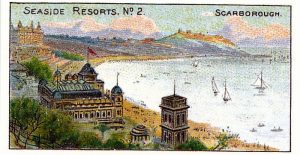
From the classic 1899 Cigarette Card set
1904 saw the introduction of electric trams and this mode of transport would remain pre-eminent locally until 1931 when busses took over. In the ’20s and ’30s, Scarborough went through a growth period as the government cleared the slums of the late 1800s and better council housing was added.
In the First World War, ships situated off the coast bombed Scarborough fairly extensively. The lighthouse was badly damaged after nearly 150 years of lighting the way to the port. The attack also hit Hartlepool and nearby Whitby. There were 529 total casualties. As well as the bombing, the young men of Scarborough joined the buddy regiment scheme. Huge swathes of friends would sign up together, ultimately going to war in the trenches with all their friends. It may have seemed like a good idea at the time, but sadly many never returned.
The Roaring 20 & slightly less Roaring 30s
The now sadly no more Futurist Theatre opened 1927, originally as a cinema and in 1931. It was demolished in somewhat controversial circumstances in 2018 and currently (2020) is an empty plot. All that remains are photos and memories.
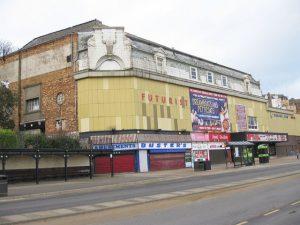
Pauline Eccles, CC BY-SA 2.0 via Wikimedia Commons
On a brighter note, the still operating Miniature Railway was opened in 1931. This is now the North Bay Heritage Railway and is one of the must-do things when you pay the town a visit. You can see it in all its glory in the 2019 video below.
Fishing Anyone?

Image: jurgal photographer/Shutterstock.com
Big Game Fishing briefly turned Scarborough into the UK’s version of Cannes when in 1929 a local showman parter with the princely sum of 50 shillings to put a huge Blue-Fin Tuna on display hoping to attract tourists (more about that below). The stunt worked big time and or a while, the rich, titled and famous flocked here, drawn by tales of huge fish waiting to be caught a few miles off the coast. Tuna transformed Scarborough from a sleepy seaside town into the Cannes of the 1930s.
High society began to flock there, drawn by tales of the huge fish that could be caught only a few miles off the coast. Special trains were laid on to ferry the rich and famous to the town from London, while others sailed their yachts here in search of that elusive monster “Thunnus thynnus”. The craze was enflamed further when in 1933 Laurie Mitchell-Henry landed what is still and likely to remain the British Rod Caught record on a boat out of nearby Whitby which weighed 851lb (around 386 kg)!
It is reported that Hollywood A-Listers such as David Niven, Errol Flynn and John Wayne came here to fish and it was not just the men as a women’s world tuna challenge cup was held at Scarborough for many years and in 1947 Bidi Evans caught a 714lb one setting the UK women’s record. The advent of WWII brought a halt to this and although they were regularly being caught in the 1940s and early 1950s the last Bluefin Tuna of note was caught here in 1954.
Bluefin No More
Anyone looking to have a go today will be out of luck as the species is now protected in British waters and although catch and release is theoretically possible we don’t know of any such operations in the UK.
Anyway on to less pleasant things…
WWII Arrives
WWII was less hard on the town than the first one but Scarborough did not escape unscathed. Sadly 137 people were killed by the German air raids and although Scarborough was an early days location for evacuated children, most had to be further relocated when it became clear that this seaside town was a target. One strange quirk was that it is thought that Hitler hoped to rule Britain from The Scarborough Grand Hotel, so although the rest of the town took a pasting this building was left intact. Fortunately, his plans for a seaside holiday were thwarted and Churchill celebrated there instead when the war finally ended.
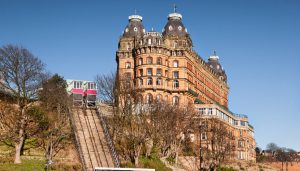
Image: travellight/Shutterstock.com
Post War Scarborough
Postwar Britains flocked back to the seaside resorts, and Scarborough was amongst the most popular, and of course, Tuna fishing resumed for a few years helping add that bit of extra glamour to the town. By 1953 the population had passed the 40k mark and in that year the decline in big game fishing was partly offset by the arrival of the fabled “Space Ship ride” nicknamed Anastasia after the famed one in the Dan Dare Comics. There was some consternation regarding its location and eventually, it was placed at the Windmill site in time for the summer season of 1953, where it proved very popular.
Scarborough kept its sense of seaside fun into the 1960s as the video of the 1961 Soap Box Derby below shows and the Futurist Theatre ( which it became in in 1958) hosted to some of the biggest names in music with The Beatles playing there in the summer of 1964 and in 1965 The Rolling Stones headlined. The Scarborough Spa Orchestra were also big then and they often featured on the BBC Radio. They are still going strong and proudly hold the title of the UK’s only remaining professional seaside orchestra. Their Facebook page is here if you want to check them out.
Modern Day Scarborough
The 1970s & 80s saw the rise of the package holiday, and this combined with the recessions which marked decades had had a significant impact on the town’s fortunes, however, things improved in the early 1990s when the then quite futuristic Scarborough Sea Life centre opened, and the impressive Brunswick Pavilion Shopping Centre arrived.
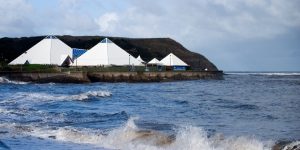
Image: Gordon Ball LRPS/Shutterstock.com
Nowadays the town is benefitting from the rise of the staycation and the resident population has swelled to over 61,000, and in the height of the summer season, this will often double. It may not be quite back to its heyday as a haunt for the rich and famous but it is well on its way!
So there we have it a potted history of the town, so now for a bit of trivia.
Fun Facts About Scarborough!
Every town has fun facts that they keep hidden so we made it our mission to find a few of these little bits of trivia which add to the character of a town. Here are the Five Minutes Spare findings on this not always sunny seaside town:
- Scarborough may have been inhabited since the Mesolithic period. There have been discoveries made in Star Carr, near Seamer, that experts believe to be the oldest house in Britain. How old? 8500 BC…
- The oldest church in town is St Mary’s Chapel, was built around 1000 AD! Not surprisingly it has needed a couple of makeovers, and it was largely rebuilt in both then 12th & 14th Centuries.
- Anne Bronte of the famous Bronte sisters saw out her days here was buried in the town in 1829.
- The now largely in ruins Scarborough Castle was built for King Stephen in 1136 who made himself Earl of York. Well, even a king needs a seaside vacation from time to time.
- In 1929 Scarborough became world-famous (well maybe not world-famous but you get the idea) when a local the Drift Steamer “Ascendant” caught a 560lb (250 kg) Atlantic Bluefin Tuna which was put on display.
- In 1988, a group of students from the area helped to create the worlds largest ever comic strip, down on the beach. As of the time of writing, they still hold that record. It isn’t every day that someone tries to draw a gigantic comic, after all.
- According to the meteorologists in an average year, it will rain in Scarborough for over 125 days, which looking on the bright side means you have around a 2 in 3 chance of picking a dry day to visit. How’s that for ending on a positive!
Famous People from Scarborough
Scarborough has been around since literally the Mesolithic era. It’s home to some of the oldest ruins in England. If there haven’t been some famous people from Scarborough to impress you with, we might as well have given up and gone home!
Here are the Five Minutes Spare favourite famous faces to have come from Scarborough:
- The Gristhorpe Man is a bronze age, fully preserved mummy, found in a coffin near town.
- The artist Ian Hunter was born in Scarborough.
- Robert Palmer, the singer who delighted many a crowd, was from Scarborough.
- The drummer from Skunk Ananse? Scarborough boy.
- Famed journalist Peter Taylor was born here, too.
There have been many a singer, actor, or performer to have their origin stories in the music halls of Scarborough. We expect we haven’t seen the last of them yet.
Things to See and Do in Scarborough
Now we get to the exciting part – where we explore the best things to see and do in Scarborough. Whether there for a few days or stopping for a few weeks, here are the delights you ought to check out…
Historic Sights and Landmarks
Scarborough Castle is one of the main attractions of the area. This iconic sight was built all the way back in the times of King Henry II. If you want a day filled with historic sightseeing, learning about the lay of the land, and enjoying superb seaside and ocean views, then this is your first stop for things to do in Scarborough.
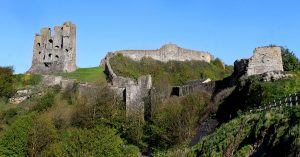
Image: Atlaspix/Shutterstock.com
Next up, the North Bay Heritage Railway, Sky Trail, and Historic Water Chute is a mouthful but a great day out. The video above will give you an overview of the railway and the sky trail. a rope trail adventure through the trees is great as long as you don’t suffer from Acrophobia. The whole area is a brilliant day out for kids of all ages!

Image: Debu55y/Shutterstock.com
St. Mary’s Church is one of the oldest buildings for miles and should be visited by anyone with an interest in spirituality or architecture.
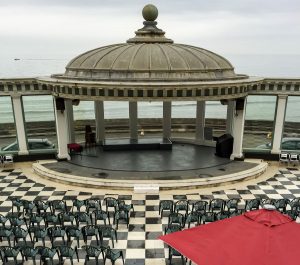
The open-air Theatre is just a tiny part of the spa experience.
mage: PhilMacDPhoto/Shutterstock.com
However, when it comes to all-round attractions in town, the Spa is one of the best sights to see. Nowadays there is a resort around it. They show live events and host conferences here. You could literally spend the day here!
Museums and Galleries
The oldest museum in Scarborough is the Rotunda, where you will learn all about the history of the town. It was built in 1829 and houses Scarborough Philosophies Collection, as well as geological representations of the surrounding land. The museum was designed by a geologist, which explains a lot once you see it.
The Scarborough Fair Collection is one of the better exhibits in town. Though technically a museum, this place specialises in vintage vehicles seen around town through the ages. This specialisation in vintage transport makes it a fir favourite among the youth.
Not technically a museum but nevertheless, take a trip with the Central Tramway Company if you can. They have historic trams that give a beautiful tour over the cliffs.
There are several galleries around town. Check out the Scarborough Art Gallery, Tracy Savage Fine Art Gallery, or the Blandscliff Gallery and Open Studio.
Outdoors and Recreation
First of all, Scarborough has a fair few beaches that you can choose between for relaxing on. Scarborough Beach is the main attraction, situated in front of the town itself, but if you go north or south in any direction you will hit more coastline. There are cliffs, rockpools, and beaches to explore all around the area. Jump in and have fun or just enjoy a good sun soak.
Scarborough isn’t short on parks, either. It is home to many a Victorian era public park where ladies could enjoy long walks. Peasholm Park is one of the best known and is actually also one of the best rated attractions in town according to the readers on Trip Advisor.
There are a few farm parks and open farms in the area. Stop by Betton Farm for a delicious menu coupled with a farm shop and animals to pet. The views are reported to be stunning, too.
Scarborough has a Sea Life centre that features some rarer underwater treats. The kids absolutely adore this place and will spend hours looking at the beautiful sea creatures through the glass. It contains a Beluga Whale sanctuary – which is fantastic news because there are so few of these rare creatures left in the world.
Things to do in Scarborough with Kids
There are a few attractions that the kids will love in Scarborough, so be prepared to go to some to keep them happy. The Playdale Farm Park is an awesome farm-come-outdoor playground where you can get a coffee or a tea while they play. You might also check them into the Alpamore water park, where they can play under the supervision of lifeguards.
Sports Teams and Stadiums
There are a few teams in Scarborough that you can watch while on holiday – or join, if you live there. Scarborough Athletic FC are the main football club in the area, The Scarborough Pirates are the best RFC club, with Scarborough even having its own cricket club.
Scarborough has its own golf club because it is British… There is the North Cliff Golf Club or the South Cliff Golf Club.
Shopping and Retail
The Brunswick Shopping Centre is still going to this very day, having now also survived through a global pandemic. You can’t miss it in the town centre. You can also shop at the Balmoral Centre or anywhere else you fancy in town. Scarborough is one of those lovely little towns with plenty of gift shops, chip shops, and other places to try out.
Other Entertainments in Scarborough
There are too many things to do in Scarborough for us to fit them all into one article – but that didn’t stop us from trying. Here are some of the top entertainments that we had to skip over a little:
- The Scarborough Open Air Theatre is a concert and show venue that has existed since the turn of the century.
- Freddie Gilroy and the Belsen Stragglers fall into the landmark category. These statues can be found all over town if you look in the right places. Make a game of it to find them.
- Cayton Bay Beach is one of the other main beaches in Scarborough and is worth a visit.
- The North Yorkshire Water Park is a fantastically fun day out for all. Be sure to supervise children here as watersports are taking place.
- The South Cliff Italian Gardens are ideal for the older tourist in Scarborough and perfect on a sunny day.
As you can see, Scarborough is jam-packed with things to see and do. Go visit it, report back, and we can add in anything we have missed.
How to Get There?
We have covered almost all the parts we love about Scarborough, but we haven’t actually told you how you get there. You can get the bus or coach to Scarborough but if you need to drive yourself, here’s how to get there.
By Road
Look for the A165. If coming from London, head straight north until you see signs for Hull, then head east.
By Rail
Look for Scarborough railway station.
By Air
Your nearest airport is Teesside airport in Darlington.
By Sea
Head for Scarborough Harbour on the west coast.
Anyway here ends our whirlwind roundup of the town. If you are planning a visit don’t forget to check out our Scarborough Directory. If you want more inspiration see our other location guides as here at five Minutes Spare, we believe each and every town city or village is special – in its own way. Whether it be a holiday village, seaside town, or commercial powerhouse city – we love each and every one of them.
Got Another Five Minutes?
If you find yourself still stuck in a rut, or anxious for something wonderful to read – then head to our home pages. Learn all about your favourite dog breeds, study up on your cities, or get to grips with a new hobby. When you have Five Minutes Spare in your back pocket, you always have something to do.
